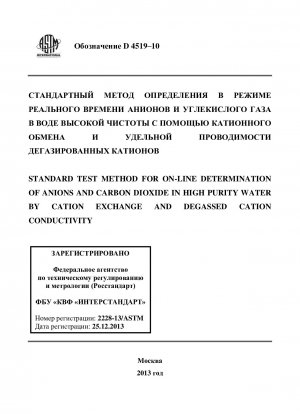ASTM D4519-10
Standard Test Method for On-Line Determination of Anions and Carbon Dioxide in High Purity Water by Cation Exchange and Degassed Cation Conductivity
- Standard No.
- ASTM D4519-10
- Release Date
- 2010
- Published By
- American Society for Testing and Materials (ASTM)
- Status
- Replace By
- ASTM D4519-16
- Latest
- ASTM D4519-16
- Scope
This test method can be a useful diagnostic tool in measuring the impurities and detecting their sources in high purity water, the steam condensate of high pressure power plants, and in the process water of certain industries requiring water of the highest purity attainable.
The measurement of such impurities is most important to these industries since plant outages or product contamination can result from events such as condenser leakage. Also, water quality deviations can occur from condensate polishing and makeup water equipment malfunctions.
The continuous measurement and trends provided by this test method are of particular interest and can indicate the need for corrections in water treating or operating procedures and equipment. The equipment for this test method can be considered more rugged and adaptable to installation under plant operating conditions than the more accurate laboratory methods, such as ion chromatography and atomic absorption.
1.1 This on-line test method includes hydrogen exchange and degassing by boiling and provides means for determining anions (such as Cl −, SO4−−, NO 3−, and F −) at levels as low as 2 μg/L (2 ppb) and carbon dioxide at the level of 0.01 to 10 mg/L (ppm) at 25°C in high purity water and steam condensate by measuring electrical conductivity.
1.2 The conductivity of all anions (except OH −) is determined and not the conductivity of an individual anion if more than one is present. If only one anion is present (such as Cl − or SO4 −−), reference to Table 1 and Table 2 or Figs. 1-3 provides the chloride or sulfate and CO2 concentration.
1.3 This test method has been improved in accuracy by using a modern microprocessor instrument for conductivity and temperature measurement and appropriate temperature compensation algorithms for compensation to 25°C.
1.4 The values stated in either SI units or inch-pound units are to be regarded separately as standard. The values stated in each system may not be exact equivalents; therefore, each system shall be used independently of the other. Combining values from the two systems may result in non-conformance with the standard.
1.5 This standard does not purport to address all of the safety concerns, if any, associated with its use. It is the responsibility of the user of this standard to establish appropriate safety and health practices and determine the applicability of regulatory limitations prior to use.
ASTM D4519-10 Referenced Document
- ASTM D1066 Standard Practice for Sampling Steam
- ASTM D1125 Standard Test Methods for Electrical Conductivity and Resistivity of Water
- ASTM D1129 Standard Terminology Relating to Water
- ASTM D1192 Standard Guide for Equipment for Sampling Water and Steam in Closed Conduits
- ASTM D1193 Standard Specification for Reagent Water
- ASTM D2777 Standard Practice for Determination of Precision and Bias of Applicable Methods of Committee D-19 on Water
- ASTM D3370 Standard Practices for Sampling Water from Closed Conduits
ASTM D4519-10 history
- 2016 ASTM D4519-16 Standard Test Method for On-Line Determination of Anions and Carbon Dioxide in High Purity Water by Cation Exchange and Degassed Cation Conductivity
- 2010 ASTM D4519-10 Standard Test Method for On-Line Determination of Anions and Carbon Dioxide in High Purity Water by Cation Exchange and Degassed Cation Conductivity
- 1994 ASTM D4519-94(2005) Standard Test Method for On-Line Determination of Anions and Carbon Dioxide in High Purity Water by Cation Exchange and Degassed Cation Conductivity
- 1994 ASTM D4519-94(1999)e1 Standard Test Method for On-Line Determination of Anions and Carbon Dioxide in High Purity Water by Cation Exchange and Degassed Cation Conductivity
